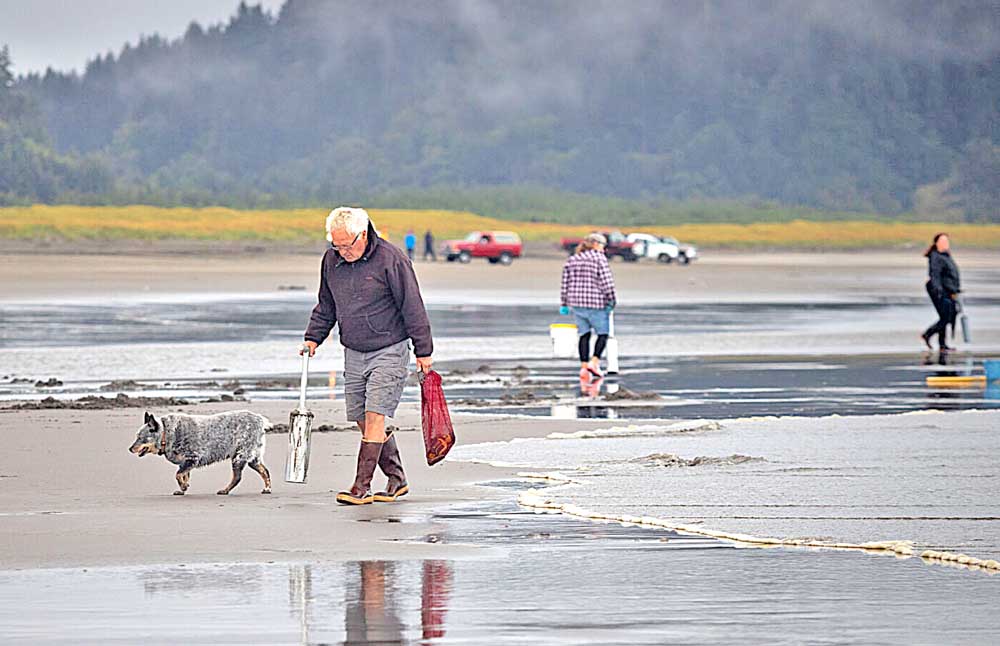Washington clam season all good so far
Published 12:55 pm Monday, January 3, 2022

- Greg Booth, of Portland, walked along the beach in September 2021 with his dog Tess searching for signs of razor clams in Seaview. “She finds them and I dig them,” said Booth, who has brought along his Australian cattle dog since she was a puppy.
WASHINGTON COAST — Razor clam season on the beaches of Pacific and Grays Harbor counties is shaping up to be one for the record books.
Trending
Although rough December weather and surf may have kept some clam diggers home, total harvest for the first three months of the season through Jan. 1 is estimated at 4.6 million. This is considerably more than the 4.2 million harvested on average during complete seasons over the past decade, said Dan Ayres, coastal shellfish manager for the Washington Department of Fish and Wildlife.
The total effort of 250,000 digger trips represents an estimated economic infusion of $23.7 million in the two counties, WDFW said.
“The additional good news is we have plenty more harvest opportunities to come,” Ayres told the Observer. Ongoing tests for the naturally occurring marine toxin domoic acid have been running far below the safety threshold — a factor that is aided by cold, storm-tossed seawater.
Trending
On the peninsula, more than 95,000 digger trips resulted in harvest of 1.8 million clams — including an estimated 88,000 clams that were wasted on account of being unlawfully discarded or other factors. Even that large harvest accounts for only 20.9% of the season quota, leaving around 6.8 million clams available for frying pans and freezers between now and the season’s end, typically in May.
Through Jan. 1 more than 1.2 million clams were dug on Twin Harbors beach — split between north Pacific and south Grays Harbor — representing 36% of its season quota, which leaves nearly 2.2 million available between now and this spring. Digger trips totaled around 68,000.
Copalis Beach, which is centered on Ocean Shores, had a three-month harvest of about 875,000, dug over the course of 47,500 digger trips. That leaves a remaining season allocation of more than 2.4 million. Mocrocks Beach, which stops at the southern boundary of the Quinault Indian Reservation, produced around 688,000 clams during 39,000 digger trips. Mocrocks has just under 1.3 million clams remaining in its 2021-22 season quota.
All four beaches were similarly productive for clammers, who enjoyed a 20-clam daily limit until Dec. 30. Average daily success on the peninsula was 18.1 clams, ranging from a high of 20 on some days in September to only five on a couple stormy days in late December. Average daily harvest per digger was 17.7 from Twins Harbors, 17.5 from Copalis and 17.3 from Mocrocks.
A current ongoing dig ends Jan. 5 with a -1.1 feet for the peninsula at 8:40 p.m.
The next full set of digs:
Jan. 14, Friday, 4:43 p.m.; +0.4 feet; Long Beach
Jan. 15, Saturday, 5:22 p.m.; +0.1 feet; Long Beach, Twin Harbors, Copalis
Jan. 16, Sunday, 5:59 p.m.; -0.2 feet; Long Beach, Twin Harbors, Mocrocks
Jan. 17, Monday, 6:34 p.m.; -0.3 feet; Long Beach, Twin Harbors, Copalis
Jan. 18, Tuesday, 7:08 p.m.; -0.4 feet; Long Beach, Twin Harbors
Jan. 19, Wednesday, 7:41 p.m.; -0.4 feet; Long Beach, Copalis
Jan. 20, Thursday, 8:14 p.m.; -0.2 feet; Long Beach









